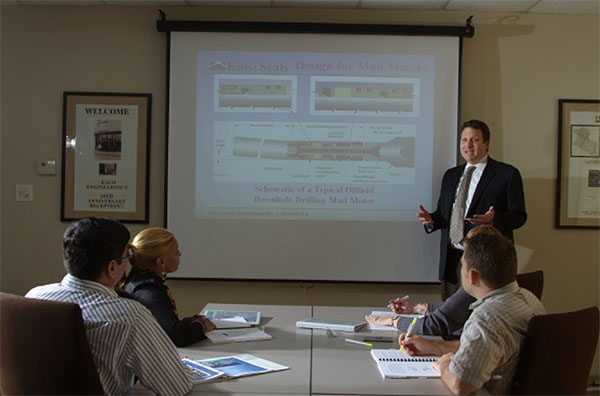Kalsi Seal-Related Engineering Training for Mud Motors

Kalsi Engineering offers a training class for engineers that covers various topics related to implementing Kalsi-brand rotary seals in oilfield downhole tools. The class typically lasts three to four hours, depending upon the number of questions, and focuses on sealed bearing mud motors. This class is offered free of charge and can be provided at your location or ours, or by web conference. It offers a general introduction to the section of the Kalsi Seal Handbook™ related to mud motors. Contact our staff to make arrangements.
The class begins with a brief introduction to Kalsi Engineering, and the principle of operation of the types of Kalsi-brand rotary seals that are used in downhole tools. This leads into to a description of the specific operational challenges experienced by low pressure seals and high-pressure seals. The design objectives, features, benefits, materials, and tradeoffs of the different types of rotary seals that we offer for downhole service are also discussed. This part of the class helps the engineer make informed decisions when selecting seals for new tool designs or upgrading older tool designs.
The mandrel-related portion of the training covers a variety of topics, including hard coatings for wear resistance, the desired surface finish of the seal running track, and appropriate diameter tolerances. Also covered are several desirable attributes of the seal installation path that should be considered to avoid seal installation damage, including proper sizing of the seal installation chamfer. Examples of installation path related seal damage are shown for emphasis. This portion of the training serves as an introduction to the several mandrel related chapters of our handbook.
A brief bearing-related portion of the class describes several potential bearing related issues, such as inadequate thrust bearing support, misorientation of spherical roller thrust bearings, misalignment-related shaft binding, spacer-related binding, thermal binding of opposed thrust bearings, and problems associated with drill string slip-stick. This portion of the class serves as a brief introduction to the “Bearing mistakes to avoid” section of our handbook.
The gland-related portion of the training covers the sizing and critical features of the seal groove that locates the rotary seal. Topics include the extrusion gap corner, groove surface finishes, extrusion gap clearance, axial extrusion gap width, pressure-related component deformation, and the optional spring loading of seals. This section of the training also covers techniques that allow small diameter rotary seals to be successfully installed and removed.
The lubricant reservoir portion of the training begins by discussing the purpose of the reservoir. Tips for designing a typical downhole reservoir with an annular pressure compensation piston are presented along with an example problem. Topics include piston fit and guidance, avoidance of pressure locking by venting between static seals, avoidance of the sticky drawer effect, reservoir sizing, reservoir and tool filling, and reducing accumulative drilling fluid-related damage to the bore of the reservoir.
The heat transfer portion of the training discusses design practices that help rotary seals run cooler. This portion begins by explaining why heat builds up in the seal track region of the rotating mandrel. Topics include axial seal spacing to avoid undue overlap of heat fields, the heat transfer interruption caused by sleeves, and relative coefficients of thermal expansion of selected steels.
If appropriate, the training also includes a discussion on the implementation of outboard barrier seals. This portion of the training emphasizes things that can be done to minimize or eliminate the risk of pressure locking between a Kalsi Seal and a barrier seal.
Click here to see the complete list of available Kalsi Seal training classes.
